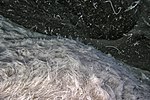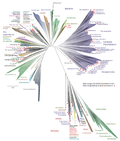 | Beggiatoa is a genus of Gammaproteobacteria belonging to the order Thiotrichales, in the Pseudomonadota phylum. These bacteria form colorless filaments... 39 KB (4,879 words) - 01:32, 23 April 2024 |
Beggiatoa leptomitoformis is a chemolithoautotrophic bacterium from the genus of Beggiatoa which has been isolated from wastewater from Moscow in Russia... 2 KB (145 words) - 14:45, 17 April 2024 |
 | known form of lithotrophy during his research with Beggiatoa in 1887. He reported that Beggiatoa oxidized hydrogen sulfide (H2S) as an energy source... 15 KB (1,483 words) - 03:40, 28 April 2024 |
 | Thioploca (section Thioploca and Beggiatoa) trichomes, morphologically similar to the genus Beggiatoa. Thioploca are often mistaken for Beggiatoa, which are close phylogenetic relatives with similar... 33 KB (3,816 words) - 13:13, 18 February 2024 |
 | Clostridium, Desulfovibrio, Chlorobium, Chromatium, Rhodomicrobium, and Beggiatoa, as well as many other species of bacteria, cyanobacteria, and algae.... 5 KB (616 words) - 18:58, 2 March 2024 |
 | communities; rather, they usually only support simple microbial mats (Beggiatoa sp.). In the upper slope environment, the hard substrates resulting from... 93 KB (10,585 words) - 07:13, 16 April 2024 |
 | can be found in plant and animal proteins. In the 1880s, while studying Beggiatoa (a bacterium living in a sulfur rich environment), Sergei Winogradsky... 98 KB (10,929 words) - 05:59, 16 April 2024 |
 | typical of the lake. The crater is covered mostly by Thiothrix sp. and Beggiatoa sp. from a depth of 1.5 m to the opening of the springcave. These together... 6 KB (566 words) - 23:29, 21 April 2024 |
bacterial photoactivated adenylyl cyclase, bPAC, of the soil bacterium Beggiatoa". The Journal of Biological Chemistry. 286 (2): 1181–1188. doi:10.1074/jbc... 108 KB (11,915 words) - 21:33, 24 April 2024 |
but cannot fix carbon dioxide (CO2). Examples: some Thiobacilus, some Beggiatoa, some Nitrobacter spp., Wolinella (with H 2 as reducing equivalent donor)... 47 KB (5,776 words) - 16:48, 27 April 2024 |
 | Clostridium, Desulfovibrio, Chlorobium, Chromatium, Rhodomicrobium, and Beggiatoa, as well as many other species of bacteria, cyanobacteria, and algae.... 153 KB (17,009 words) - 04:52, 20 April 2024 |
marine sediments. For example, benthic sulfur bacteria in genera such as Beggiatoa and Thioploca inhabit anoxic sediments on continental shelves and obtain... 20 KB (2,404 words) - 23:19, 5 March 2024 |
genus of filamentous sulfur-oxidizing bacteria, related to the genera Beggiatoa and Thioploca. They are usually Gram-negative (but can be Gram-variable)... 7 KB (806 words) - 11:29, 29 November 2023 |
violaceum Warming 1875 Bacterium okenii (Ehrenberg 1838) Trevisan 1879 Beggiatoa roseopersicina Zopf 1883 Rhabdochromatium roseum (Cohn 1875) Winogradsky... 2 KB (99 words) - 21:00, 11 March 2022 |
 | Small but potent PACs were identified in the genome of the bacteria Beggiatoa (bPAC) and Oscillatoria acuminata (OaPAC). While natural bPAC has some... 10 KB (987 words) - 03:51, 29 November 2023 |
marine microorganisms, including Thiomicrospira, Halothiobacillus, and Beggiatoa, are capable of oxidizing sulfur compounds, including elemental sulfur... 15 KB (3,420 words) - 16:59, 29 March 2024 |
 | the base are orange bacterial mats of the sulfide-oxidizing bacteria Beggiatoa spp. and empty shells of various clams and snails, which are also common... 4 KB (484 words) - 12:30, 2 December 2023 |
Thiotrichales Family: Thiotrichaceae Garrity et al. 2005 Genera Achromatium Beggiatoa Leucothrix Thiobacterium "Candidatus Thiolava" Thiomargarita Thioploca... 1 KB (61 words) - 17:22, 3 May 2022 |
 | SO2– 4 + 2 H+ In modern oceans, Thiomicrospira, Halothiobacillus, and Beggiatoa are primary sulfur oxidizing bacteria, and form chemosynthetic symbioses... 48 KB (5,855 words) - 10:27, 19 March 2024 |
 | is Phormidium corallyticum. Sulfide-oxidizing bacteria, dominated by Beggiatoa spp., are present in well-developed bands and exhibit visible vertical... 9 KB (1,029 words) - 19:03, 19 February 2023 |










